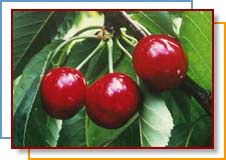Home | FOOD ARTICLES | Food Trivia | Today_in_Food_History | Food_History_Timeline | Recipes | Cooking_Tips | Food_Videos | Food_Quotes | Who’s_Who | Culinary_Schools_&_Tours | Food_Trivia_Quizzes | Food_Poems | Free_Magazines | Food_Festivals_and_Events
Food Articles, News & Features Section
FREE Magazines
and other Publications
Free Professional and Technical Research, White Papers, Case Studies, Magazines, and eBooks
CHERRIES
See also: History of Cherries; Cherry Trivia; Cherry Tips;
Cherry Quotes; Cherries Jubilee
Cherries are drupes, or stone fruits, related to plums and more distantly to peaches and nectarines. They have been enjoyed since the Stone Age-pits were found in several Stone Age caves in Europe. The Romans carried cherries throughout Europe and England along the routes of conquest.
Cherries are grown in several regions of this country, but seventy percent of the cherries produced in the United States come from four states (Washington, Oregon, Idaho, and Utah).
VARIETIES
There are two main types of cherries: sweet and sour. Sour cherries are lower in calories and higher in vitamin C and beta carotene than sweet cherries.
Sour
Montgomery
This variety is the best known sour cherry. It is mostly canned or frozen for use as pie filling or sauce. They are grown mostly in the eastern and Midwestern states.

Sweet
Bing
This variety is the best known sweet cherry. It is large, round, extra-sweet and has a purple-red flesh and a deep red skin that is close to black when fully ripe. The Bing is available from the end of May until early August.
Lambert
This variety is the second most popular sweet cherry. It is smaller than the Bing and is more heart shaped. It has a dark-red skin and a rich flavor. Lamberts are available a bit longer than the Bing, usually until the end of August.
Rainer
This variety is sweet with a yellow or pinkish skin. It is milder and sweeter than the Bing. However, this variety is grown in limited quantities.
Royal Ann
This variety has a blush-yellow skin and is often canned or made into maraschino cherries.
SELECTION

Buy cherries that have been kept cool and moist, as flavor and texture both suffer at warm temperatures. Cherries have a limited growing season and any fresh cherries grown in the United States sold after August probably came from cold storage. Small quantities of sweet cherries are imported from New Zealand during the winter months, but these may be difficult to find.
At the market, pick a handful of cherries at a time and only select the best fruit. This may be time-consuming, but the reward will be better cherries. Good cherries should be large (one inch or more in diameter), glossy, plump, hard and dark-colored for their variety. Buy cherries with stems on — they should be fresh and green. Reject undersized cherries or those that are soft or flabby. Avoid fruit that is bruised or has cuts on the dark surface.
If you find many damaged fruits at the market, consider buying cherries somewhere else, as a number of spoiled cherries will start the others to decay.
STORAGE
Loosely pack unwashed cherries in plastic bags or pour them into a shallow pan in a single layer and cover with plastic wrap to minimize bruising. Store cherries in the refrigerator and cherries in good condition should last up to a week. Check the fruit occasionally and remove the cherries that have gone bad. Wash the fruit before eating.
You can freeze cherries by rinsing and draining thoroughly, spreading them out in a single layer on a cookie sheet and placing in the freezer overnight. Once the cherries are frozen, transfer them to a heavy plastic bag. The frozen fruit may be kept up to a year.
PREPARATION
Most cherries bought at the market are eaten raw, alone or accompanied by other fruits. Simply wash the fruit and serve with the stems.
For cooking, pit cherries either by hand or with a pitter. Poaching is the most common form of preparation. Drop cherries into a small amount of simmering water, or a combination of water and wine, and cook for one to three minutes until soft. Poach using the formula of one cup liquid to two cups cherries.
- Make Cherries Part of Your 5 A Day Plan
- Add cherries to a fruit salad to add color, flavor and variety.
- Poached cherries make an excellent topping for low fat ice cream or low fat frozen yogurt.
- Dried cherries add sweetness to oatmeal or trail mix.
RELATED ARTICLES
Please feel free to link to any pages of FoodReference.com from your website.
For permission to use any of this content please E-mail: james@foodreference.com
All contents are copyright © 1990 - 2025 James T. Ehler and www.FoodReference.com unless otherwise noted. All rights reserved.
You may copy and use portions of this website for non-commercial, personal use only.
Any other use of these materials without prior written authorization is not very nice and violates the copyright.
Please take the time to request permission.


